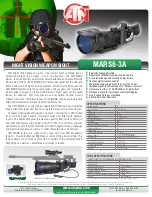
58 • Telescope Maintenance
To check the collimation of your telescope you will need a light source. A
bright star near the zenith is ideal since there is a minimal amount of atmo-
spheric distortion. Turn your telescope motor drive on so that you don’t have to
manually track the star. Or, if you are not using the motor drive, use Polaris.
Its position relative to the celestial pole means that it moves very little thus
eliminating the need to track it.
Before you begin the collimation process, be sure that your telescope is in
thermal equilibrium with the surroundings. Allow 45 minutes for the telescope
to reach equilibrium if you move it between large temperature extremes.
To verify collimation, view a star near the zenith. Use a medium to high power
ocular — 12mm to 6mm focal length. It is important to center a star in the
center of the field to judge collimation. Slowly cross in and out of focus and
judge the symmetry of the star. If you see a systematic skewing of the star to
one side, then recollimation is needed.
To accomplish this, you need to adjust the secondary collimation screw(s) that
move the star across the field toward the direction of the skewed light (see
figure 8-1). Make only small corrections, approximately 1/6 to 1/8 of the field.
Recenter the star by moving the telescope before making further adjustments.
When using higher power, 6mm and above, collimation is best accomplished
with the telescope in focus. In this instance, you are observing the Airy disk
(see figure 8-2), not the shadow of the secondary housing. This (stellar) image
appears as a bright point of light with a diffraction ring around it. When the
point of light is perfectly centered within the diffraction ring, your telescope is in
collimation. Keep in mind that to use high power, the seeing conditions must
be very good.
Perfect collimation yields a star or planetary image very symmetrical just
inside and outside of focus. Also, perfect collimation delivers the optimal
optical performance specifications that your telescope is built to achieve.
If seeing (i.e., air steadiness) is turbulent, collimation is difficult to judge. Wait
until a better night if it is turbulent or aim to a steadier part of the sky. A
steadier part of the sky is judged by steady versus twinkling stars.
NOTE:
THE ADJUSTMENT SCREWS ON THE SECONDARY MIRROR ARE VERY
SENSITIVE. USUALLY A TENTH OF A TURN WILL COMPLETELY
CHANGE THE COLLIMATION OF THE TELESCOPE. DO NOT FORCE
THESE SCREWS IF THEY WILL NOT TURN. IF TIGHTENING ONE SCREW
IN THE DIRECTION YOU NEED TO GO IS DIFFICULT, SIMPLY LOOSEN
THE OTHER TWO SCREWS BY EQUAL AMOUNTS TO BRING ABOUT THE
SAME CHANGE. DO NOT BE INTIMIDATED BY TOUCHING UP COLLIMA-
TION AS NEEDED TO ACHIEVE OPTIMAL HIGH-RESOLUTION VIEWS. IT
IS WORTH THE TROUBLE!!!!
Figure 8-1
Left: With an out-of-focus
star image at the center of
the field, the secondary
mirror shadow is off center
indicating the telescope is
out of collimation Right: The
out-of-focus star image
showing good collimation.
Figure 8-2
In focus images show the
C8 in collimation (left) and
out of collimation (right).




































